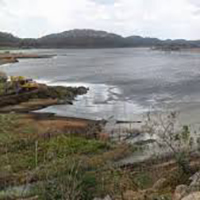Spatio-temporal variation of cyanobacteria and cyanotoxins in public supply reservoirs of the semi-arid region of Brazil
Cyanobacteria and cyanotoxins in reservoirs of the semi-arid region

Accepted: 16 September 2019
HTML: 151
All claims expressed in this article are solely those of the authors and do not necessarily represent those of their affiliated organizations, or those of the publisher, the editors and the reviewers. Any product that may be evaluated in this article or claim that may be made by its manufacturer is not guaranteed or endorsed by the publisher.
Authors
Cyanobacteria harmful algal blooms (CyanoHABs) have become increasingly frequent and intense in public supply reservoirs as a result of eutrophication and global climate change. The semi-arid region of Brazil has a well documented history of CyanoHABs but the underlying factors that control the excessive proliferation of these organisms and the production of their bioactive secondary metabolites are not comprehensively understood. This study aimed to identify the environmental factors that explain the spatial and temporal variations in the abundance of cyanobacteria and the concentration of cyanotoxins (microcystins, saxitoxins, and cylindrospermopsin) in semi-arid reservoirs. The following hypotheses were tested: (a) the largest biovolumes of potential toxin producing cyanobacteria occur when cyanotoxin concentrations are highest; and (b) the environmental factors that explain variations in biovolume of cyanobacteria also explain changes in cyanotoxins concentrations. Samples were taken from four reservoirs located in the Northeast region of Brazil, over a three-month period (October 2016 and February and June 2017). Of the 24 species of cyanobacteria identified, 13 were potentially toxin-producing. Physicochemical variables such as water volume of the reservoir, water transparency, soluble reactive phosphorus, and total phosphorus explained the abundance of cyanobacteria and the levels of cyanotoxins. These results corroborate the hypothesis that similar physicochemical conditions influence the abundance and diversity of cyanobacteria and cyanotoxins. Cyanobacterial blooms composed of more than one potential toxin producing species were observed in the studied reservoirs, where potential microcystin-producing species were the most common. Microcystins and saxitoxins were detected in all the reservoirs studied, while cylindrospermopsin and the cyanobacterium Cylindrospermopsis raciborskii were simultaneously recorded in only one reservoir (Camalaú Reservoir). Cylindrospermopsin was only detected in a reservoir for the first time in the State of Paraíba. Canonical redundancy analysis showed that the cyanotoxins were related to potential toxin producing species. These results corroborate the proposed hypothesis that there is a correlation between cyanotoxins and the biomass of potential producers. Also, there were situations where cyanotoxins were detected without the presence of potential producers. These results demonstrate the need for reassessment of potential toxin producing species of cyanobacteria in semi-arid reservoirs. This may lead to the identification and characterization of novel producers of these bioactive secondary metabolites.
Edited by
Andrea Lami, CNR-IRSA Verbania, ItalyHow to Cite
Similar Articles
- Marco Pilotti, Giulia Valerio, Luca Gregorini, Luca Milanesi, Charlie A.R. Hogg, Study of tributary inflows in Lake Iseo with a rotating physical model , Journal of Limnology: Vol. 73 No. 1 (2014)
- Clara E. Moreno, Eirik Fjeld, Min K. Deshar, Espen Lydersen, Seasonal variation of mercury and δ15N in fish from Lake Heddalsvatn, southern Norway , Journal of Limnology: Vol. 74 No. 1 (2015)
- Vanessa Virginia Barbosa, Juliana dos Santos Severiano, Dayany Aguiar de Oliveira, José Etham de Lucena Barbosa, Influence of submerged macrophytes on phosphorus in a eutrophic reservoir in a semiarid region , Journal of Limnology: Vol. 79 No. 2 (2020)
- Angela Boggero, Lyudmila Kamburska, Silvia Zaupa, Marzia Ciampittiello, Michela Rogora, Tiziana Di Lorenzo, Synoptic results on the potential impacts of the Lake Maggiore water management strategy on freshwater littoral ecosystems and invertebrate biocoenosis (NW, Italy) , Journal of Limnology: Vol. 81 No. s2 (2022): Effects of water level management on lake littorals and downstream river areas
- Franco GIOVANARDI, Maria Grazia FINOIA, Simone RUSSO, Marina AMORI, Bianca DI LORENZO, Coastal waters monitoring data: frequency distributions of the principal water quality variables , Journal of Limnology: Vol. 65 No. 2 (2006)
- Nico SALMASO, Ecological patterns of phytoplankton assemblages in Lake Garda: seasonal, spatial and historical features , Journal of Limnology: Vol. 61 No. 1 (2002)
- Monika Tarkowska-Kukuryk, Tomasz Mieczan, Effect of substrate on periphyton communities and relationships among food web components in shallow hypertrophic lake , Journal of Limnology: Vol. 71 No. 2 (2012)
- Anna Rychła, Edyta Buczyńska, Anna Maria Szczucińska, The environmental requirements of Crunoecia irrorata (Curtis, 1834) (Trichoptera: Lepidostomatidae) and the potential of the species for use as an indicator: an example from the Vistulian glaciation area , Journal of Limnology: Vol. 74 No. 3 (2015)
- Eva Pažourková, Josef Křeček, Peter Bitušík, Pavel Chvojka, Lenka Kamasová, Takaaki Senoo, Jan Špaček, Evžen Stuchlík, Impacts of an extreme flood on the ecosystem of a headwater stream , Journal of Limnology: Vol. 80 No. 2 (2021)
- Oliver Skibbe, Nelida Abarca, Francine Forrest, Petra Werner, Exploring diatom diversity through cultures - a case study from the Bow River, Canada , Journal of Limnology: Vol. 81 (2022)
<< < 31 32 33 34 35 36 37 38 39 40 > >>
You may also start an advanced similarity search for this article.
-
Juliana dos Santos Severiano, Edlayne Rayanara Pontes de Lima, Daniely de Lucena-Silva, Dayrla Kelly Gomes Rocha, Maria Eduarda Santana Veríssimo, Bruno Renaly Souza Figueiredo, José Etham de Lucena Barbosa, Joseline MolozziWater Research : 2023
-
Thiago Santos de Almeida Lopes, Amanda Myrna de Meneses e Costa, Whelton Brito dos Santos, Weruska Brasileiro Ferreira, Patricia Herminio CunhaCadernos Técnicos Engenharia Sanitária e Ambiental : 2023
-
Ranielle Daiana dos Santos-Silva, Juliana dos Santos Severiano, Mathias Ahii Chia, Tatiane Medeiros Queiroz, Micheline Kézia Cordeiro-Araújo, José Etham de Lucena BarbosaEnvironmental Pollution : 2024
-
Flávia Morgana Monteiro, Gustavo Correia de Moura, Juliana dos Santos Severiano, Camila Ferreira Mendes, José Etham de Lucena BarbosaAquatic Ecology : 2021
-
Andreia Souza Regis, Ronaldo Faustino da Silva , Fabio Henrique Portella Corrêa de Oliveira, Eduardo José Alécio de OliveiraRevista de Gestão Social e Ambiental : 2024

 https://doi.org/10.4081/jlimnol.2019.1893
https://doi.org/10.4081/jlimnol.2019.1893





